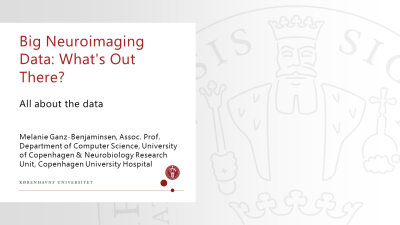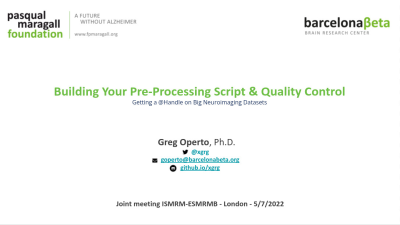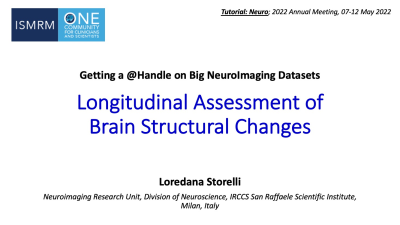Onsite Tutorial
Getting a @Handle on Big Neuroimaging Datasets
Joint Annual Meeting ISMRM-ESMRMB & ISMRT 31st Annual Meeting • 07-12 May 2022 • London, UK

| All About the Data | |||
| 08:00 |  |
Big Neuroimaging Data: What's Out There?
Melanie Ganz-Benjaminsen
In my educational talk, I will introduce you to the world of neuroimaging data sharing. In the start, I will motivate why neuroimaging data sharing is a good idea and you should not only benefit from it, but actually actively participate in it. Next, I will focus first on the different types of data that can be shared, then introduce data formats for sharing and finally highlight different data sharing initiatives. I will end with a short list and overview over the especially large data sets that are available.
|
|
| 08:25 | How to Effectively Store & Organize Large Data
Simon Doran
|
||
| Checking & Preparing Big Data | |||
| 08:50 |  |
Building Your Pre-Processing Script & Quality Control
Grégory Operto
Recent decades have witnessed an increasing number of large imaging studies. In particular for organizations with their own imaging equipment, configuring a system to collect, manage, process, review those datasets is still complicated, and relying on cloud-based solutions, albeit promising, is not always possible. We present a practical model aimed at improved quality control and guided by principles including user involvement, lightweight footprint, modularity and facilitated data sharing. This model gave rise to an ecosystem of independently reusable tools shaped around XNAT. This paradigm is scalable to the general community of researchers working with large imaging datasets.
|
|
| 09:15 | Harmonization of Huge Data & Preparing It for Machine Learning
Jean-Baptiste Poline
In this lecture, I will review both the need for and the benefits of data harmonization and standardization. I will present some of the tools available to the community. I will take a specific example of distributed Parkinson data harmonization. I will list some of the challenges that remain ahead of us and how these can be addressed.
|
||
| 09:40 | Break & Meet the Teachers |
||
| Brain Structure & Longitudinal Changes | |||
| 10:05 | Quantifying & Visualizing Brain Morphology
Da Ma
This talk will present several different approaches and best practice to achieve effective quantify and visualize brain morphology. First, we will demonstrate qualitative and quantitative methods to perform, visualize, and evaluate the effect of multi-site neuroimage data harmonization for removing unwanted confounding factors. Second, we will illustrate visualization methods for various brain morphology metrics, such as structural volume, cortical thickness, that can reveal individualized brain morphology patterns. Lastly, we will introduce the parametric statistical analysis and visualization approach for presenting the groupwise brain morphology variation across large population.
|
||
| 10:30 |  |
Longitudinal Assessment of Brain Structural Changes
Loredana Storelli
The talk will propose an overview of the mainly available pipelines to assess longitudinal brain structural changes and to focus on the best practice to perform these quantifications. In the first part, we will introduce the basic concepts on the research questions and technical aspects to guide in the selection of the most suitable longitudinal pipeline among the available ones. In the second part we will see practically step-by-step how to perform a global and regional assessment of brain volumetric changes, using an open-access dataset. The participants will finally be able to independently perform such analyses and critically interpret it.
|
|
| Hands-On Brain Connectivity | |||
| 10:55 | Hands-On: Structural Connectivity with Diffusion MRI
Robert Smith
This talk will give an introductory overview of the quantification of white matter structural connectivity using diffusion-weighted imaging. First, we clearly define the scope of the task of characterising the nebulous property referred to as "connectivity" in this domain, and provide important contextualisation of its relevance to the ever-popular field of connectomics. Second, we use a publicly-available tutorial with accompanying data to briefly demonstrate some of the processing steps involved in producing a connectome matrix from DWI data. Finally, we enumerate some issues for contemplation when intending to process DWI data across large datasets.
|
||
| 11:20 | Hands-On: Functional Connectivity with BOLD MRI
Jingyuan Chen
This talk will give an introductory overview of “functional connectivity (FC)” analysis using fMRI. First, I will review the signal characteristics of fMRI and the definition of FC in this specific context. Next, I will walk through the basic principles and practical considerations centered on seed-based FC analysis, network parcellation, and graph theoretical analysis of functional connectome. Simple real-data examples and Matlab scripts are provided for the audience to gain hands-on experience with these analyses. Finally, I will briefly discuss the benefits and challenges associated with studying FC using big data. Link to the tutorial video and codes: https://tinyurl.com/ISMRM2022-JingyuanChen.
|
||
The International Society for Magnetic Resonance in Medicine is accredited by the Accreditation Council for Continuing Medical Education to provide continuing medical education for physicians.